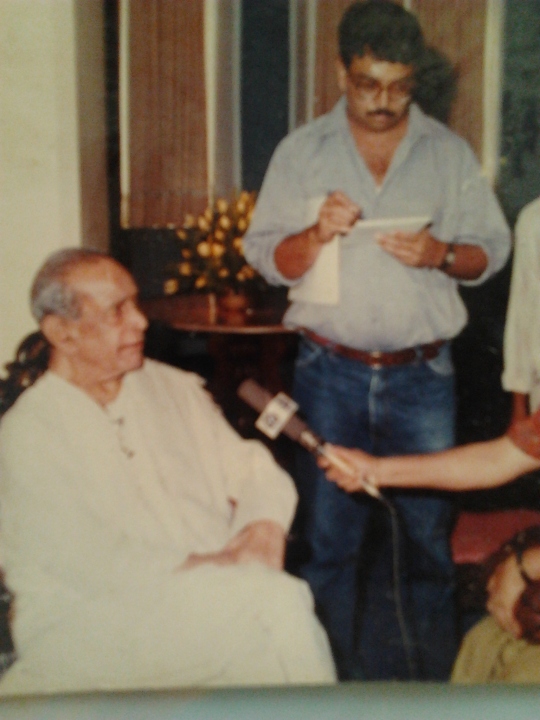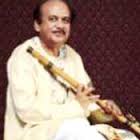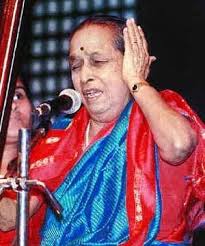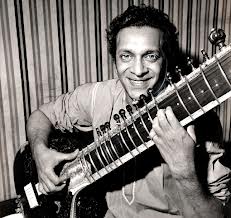
(In picture); Pandit Bhimsen Joshi at the Taj Mahal Hotel, Mumbai, in 1997 for the launch of the six-cassette series to mark his 75th birthday. That’s me in the centre, holding a notebook and pen, not a plate and spoon as some might think!
—————————————————————————————–
Today, January 24 2013, is the second death anniversary of Kirana gharana doyen Pandit Bhimsen Joshi, one of the greatest voices the world has ever heard. As a tribute, I look back at the three times I met him as a journalist. Each meeting had a different setting and result, but was memorable in its own way.
Meeting No 1
January 1995
I still remember that morning when I suddenly bumped into Bhimsen-ji at a hotel in Indore, Madhya Pradesh. I had just joined Mid Day newspaper as chief sub editor on the business desk. I didn’t write articles those days, and was yet to enter the totally exciting domain of music journalism.
Bhimsen-ji was staying in the next room. He stood in the corridor outside, humming a tune. I didn’t want to disturb him, but his eyes met mine, and I nodded my head in respect. He smiled, and not knowing how to begin the conversation, I asked him in Kannada: “Bhimsen Joshi avaru?”
As that would literally translate to “Are you Bhimsen Joshi?”, I felt rather embarrassed the moment I completed my question. He replied, “Houdu.” Which means ‘Yes”. There was a pause, after which he asked: “Yaav ooru?” Which city? I said, Dharwad. The north Karnataka connection was made. The ice was broken.
Bhimsen-ji was in Indore for a concert. When I told him my surname, he recalled meeting my grandfather when he was still young, much before I was born. And when I told him my profession, he invited me to his room to do an article on him.
Honestly, I didn’t know what to do, as I wasn’t ready to interview such a legend. I didn’t have the guts, or even that writer’s instinct. The thought didn’t excite me much. I wanted to escape. And so, I lied to him. Through my teeth.
I told him I had to rush to catch a flight (which was actually much later in the evening), and would definitely meet him some other time. We exchanged telephone numbers. We spoke for a few minutes about Dharwad, its weather and its pedhas. We bid each other goodbye, and he returned to the tune he was humming.
Later, while returning to Mumbai, I kept wondering why I had shunned that golden chance. I had known a fair bit about Indian classical music, because my mother was a student, and we used to go to Pandit Jasraj’s house from the time I was eight or nine years old.
I knew the basic things about Bhimsen-ji too, and had even attended his concerts and listened to his recordings. I admired his ragas Puriya, Maru Bihag and Marwa, not because I understood them, but because my uncles played them so often, and I found them aesthetically appealing. ‘Jamuna ke Teer’, ‘Jo Bhaje Hari ko Sada’, ‘Bhagyada Lakshmi Baaramma’ and ‘Teerth Vithal’ were songs I personally loved. They moved me each time.
I knew that Bhimsen-ji hailed from north Karnataka, and he was now settled in Pune. I knew a bit about his life and how he found his guru Sawai Gandharva nearer home after searching for a teacher in various places across India. I had heard stories of his drinking days too, and that he had given up the habit. His senior disciple Madhav Gudi was even known closely to our family.
I could have easily done that interview, but I didn’t. And I didn’t even follow the classical music etiquette of touching his feet before leaving. The thought never struck me.
For a few days, I tried to console myself. How could a struggler like me interview such a famous personality? That too without any proper preparation? At such short notice? What if I showed my ignorance about certain things he might talk of? Details of ragas and names of other musicians? At the same time, if I had bumped into my favourite rock musicians Ian Anderson and Eric Clapton, wouldn’t I have gone any length to interview them?
I mentioned this meeting to my father a few days later, but otherwise, kept it to myself. I didn’t dare tell my seniors at Mid Day. I don’t remember where I kept Bhimsen-ji’s telephone number. And I gradually forgot about the incident, though somewhere deep inside, I regretted my action. I still do.
Meeting No 2
January 1997
THE Gateway Room of Mumbai’s luxurious Taj Mahal Hotel was filled with mediapersons. There were quite a few TV channels hungry for their bytes, newspaper journalists looking for interviews and seasoned classical music critics who had been personally invited by the label Music Today for the launch of the six-cassette ‘Bhimsen Joshi Series’.
By this time, I had spent a year and a half in music journalism. I normally covered jazz, rock, ghazals and Indipop, but had also written about a few younger classical musicians. I loved classical music, but my knowledge of the subject was very basic. I was yet to interview any of the senior artistes, but through a few concert visits and press conferences, had begun to gain an understanding of how the classical world functioned. Of the difference between ‘tameez’ and ‘tauheen’.
The series was being launched on the eve of Bhimsen-ji’s 75th birthday, which was to fall on February 4. In the crowd, I did manage to meet him for a minute. Instantly, I touched his feet, and spoke in Kannada about our earlier meeting, which he had obviously forgotten.
I was hoping to get a few minutes of exclusive time with him, but the organisers didn’t permit that. So I was grouped with two channels and two other newspapers, and wasn’t allowed to speak because it would disturb the TV footage.
I had done my homework this time, and prepared a few questions, including seemingly-technical ones. But the TV channels grabbed all the attention, naturally. I just jotted down whatever he told the camera, and based on those notes and my own background work, wrote an article which appeared like he had spoken exclusively to me. Boss was happy. I too was convinced I could now cover classical music.
The good thing, of course, was that Music Today presented each journalist with the entire six-cassette set. It contained some of Bhimsen-ji’s older recordings ― ragas Multani, Puriya Dhanashree, Yaman Kalyan, Brindabani Sarang, Asavari Todi and Chhaya Malhar, besides thumris in Bhairavi and Khamaj, and Marathi natya sangeet.
Over the next few days, I heard all those tapes, and discovered a wealth of music. I also went back to some of Bhimsen-ji’s ragas and bhajans I had heard while growing up. It was the beginning of a phase, which continues today.
Soon, I converted myself from someone fond of Hindustani classical music to someone passionate about it. I attended as many concerts and music festivals as possible, and read books by Mohan Nadkarni and Raghava R Menon. I heard the familiar recordings of Jasraj and Kumar Gandharva, and the unfamiliar ones of Kishori Amonkar and Ustad Amir Khan. I tried to follow Shivkumar Sharma, Hariprasad Chaurasia and Amjad Ali Khan with greater interest. I wanted to learn as many new things as I could.
If any inhibitions still existed about interviewing legendary musicians, they were smashed a couple of weeks later during my first meeting with Pandit Ravi Shankar. The sitar maestro had been so warm and friendly, that never for once had I thought I was speaking to such a senior and admired artiste. I was captivated and hooked.
Meeting No 3
October 2001
IT was meant to be a historic concert, appropriately named ‘Tapasya’. On Gandhi Jayanti, 2001, three of the country’s finest vocalists were scheduled to appear at Mumbai’s Shanmukhananda Hall. Pandit Jasraj, Pandit CR Vyas and Bhimsen-ji were to sing in that order, the seniormost always appearing last.
The previous day, I had met Bhimsen-ji for an interview. All the fears about meeting great classical musicians had disappeared long ago, and I had myself requested the organisers to fix up the interview. By this time, I was heavily into classical music, though my colleague Amit Karmarkar, a sports reporter at Mid-Day, invariably gave me a complex with his extensive knowledge of ragas and bandishes.
Bhimsen-ji’s son Shrinivas was with him that time, and was initially trying to answer on his father’s behalf. English newspaper, English translation. But seeing me ask a few questions in Kannada, he backed out.
It took a while for Bhimsen-ji to open up, but once he did, there was no stopping him. In every way, the conversation was like the unfolding of a raga, starting at a slow, leisurely pace like the alaap, and then picking up tempo gradually, before culminating in a volley of words. He expressed himself so naturally and effortlessly that I felt he was actually singing boltaans, taans and gamaks.
The conversation lasted well over an hour. Bhimsen-ji talked about many things, beginning with the early days of classical music when there were baithaks and all-night concerts. He described how he was influenced by Kirana gharana legend Ustad Abdul Karim Khan. He talked of his guru Sawai Gandharva, gurubahen Gangubai Hangal, gurubhai Pandit Firoz Dastur, the Kirana gharana in specific and the other gharanas in general. He spoke of the importance of guru shishya parampara – GSP in my notes.
He talked of singers like Bade Ghulam Ali Khan, Amir Khan, Omkarnath Thakur and Dattatreya Vishnu Paluskar, even Lata Mangeshkar and Asha Bhosle. He praised the harmonium greats Appa Jalgaonkar, Purushottam Walawalkar and Tulsidas Borkar, and tabla maestros Shaik Dawood and Nana Mulay. He mentioned the challenges faced by the genre, and also expressed hope that there was a lot of young talent around. He was in a mood, and he was in his element.
Sadly, because of heavy advertisements and a fewer number of pages in next day’s holiday newspaper, a lot of points made in the interview had to be cut. The published version was only about 400 words, and though I did try my best to get the entire interview published later, it didn’t materialise. Unfortunately, I didn’t even keep the book in which I had taken down my notes, just in case I needed them later. And I never recorded interviews.
On October 2, Shanmukhananda Hall witnessed a memorable concert. Jasraj first sang raga Purvi and the famous bhajan ‘Om Namoh Bhagwate Vasudevaya’. CR Vyas then rendered Shuddha Kalyan and Bihag. And Bhimsen-ji completed the proceedings with Puriya Kalyan, a thumri in Kirwani and the famous Bhairavi bhajan ‘Jo Bhaje Hari Ko Sada’.
After that, I saw Bhimsen-ji only once in concert, singing Puriya Dhanashree at the Nehru Centre a couple of years later. He sang well, but not for too long, and definitely not in the same range. Healthwise, he had been having ups and downs, and his visits to Mumbai decreased.
I too shifted jobs and career, and never met him after that. But I kept exploring his music. Besides the ragas and popular devotional songs, I got into his Kannada bhajans and Marathi abhangs. My new favourites were ‘Sada Enna Hrudayadalli’ and ‘Maajhe Maaher Pandhari’.
The end
January 24, 2011
I was in Chennai for a fortnight to conduct a training programme. As my guest house was just behind the famous Music Academy, I attended a lot of Carnatic concerts after work. On January 23, I was at a fusion show featuring flautist Hariprasad Chaurasia, saxophonist George Brooks and Gwyneth Wentinck on harp.
I was still reeling under the magic of that event, and recalling my short meeting with Chaurasia, when I casually put on the TV the next morning. The headlines read, ‘Bhimsen Joshi Dead’. I was stunned. Not knowing what to do next, I informed my colleagues that I would start the training a couple of hours later. Soon, tributes began flowing from everywhere ― on TV channels, on SMS, on Facebook. I joined the nation in its sorrow.
Though I was in for a hectic day and knew it would be practically difficult to meet deadlines, I just hoped some newspaper would request me to write an obituary. Nobody called, and I let it pass. Since I wasn’t carrying any of his music on that tour, I picked up a few of his CDs and spent the next few days listening to ragas Kaunsi Kanada, Puriya, Ahir Bhairav and Shuddha Sarang.
The memories of those three meetings came back to me, as they do again today. Each had a different outcome. In the first encounter, he had requested me to write about him, and I foolishly ran away. In the second, I had prepared myself, but didn’t get a chance to ask what I wanted to. And in the third, he had spoken at great length, but because of space constraints, I could publish only a fraction of it. Three interactions, three outcomes.
Whatever the fate of those meetings, the fact is that Bhimsen-ji’s gayaki has moved me as much as it has millions of other rasikas. His voice, undoubtedly, has been one of God’s biggest gifts to the art of creative expression. He had his own style, his own approach. He symbolised the golden era of Hindustani classical music, and he shall enchant our hearts and minds forever.











